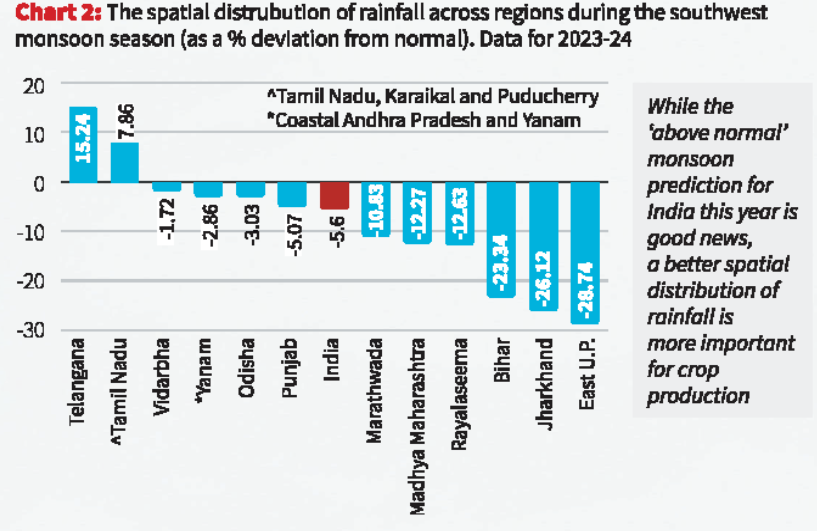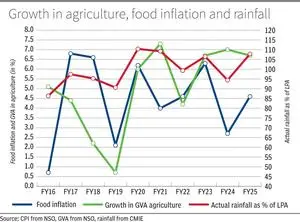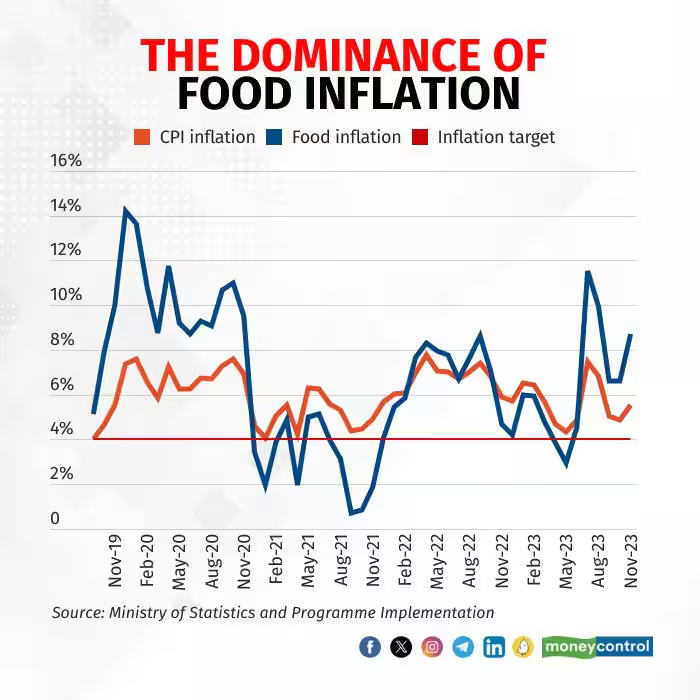Monsoon & Food Inflation in India | 25 Apr 2025
For Prelims: Retail inflation, Food Price gains, Consumer Price Index (CPI), CPI-Combined (CPI-C), WPI, Cost-push inflation, drip irrigation, headline inflation, Indian Meteorological Department
For Mains: Impact of Monsoon on Food Inflation in India, Significance and Challenges of Food Inflation for Indian Economy.
Why in News?
The Indian Meteorological Department (IMD) in its first forecast for 2025 has forecasted an above-normal monsoon for 2025 which will support agricultural output and aid the government’s efforts to contain food inflation, which is highly sensitive to rainfall variability.
What is IMD's Forecast on Monsoons for 2025?
- Rainfall Prediction:
- IMD has forecast an “above normal” southwest monsoon in 2025, with rainfall likely at 105% of the Long Period Average (87 cm), ±5% margin.
- IMD classifies monsoon rainfall as: Deficient (<90% of LPA), Below Normal (90–95%), Normal (96–104%), Above Normal (105–110%), and Excess (>110%).
- This is backed by neutral El Niño–Southern Oscillation (ENSO) and Indian Ocean Dipole (IOD) conditions and below-normal snow cover over Eurasia, which supports stronger monsoons.
- IMD’s forecast accuracy has improved, with average deviation reducing to 2.27% (2021–25) from 7.5% (2017–20).
- IMD has forecast an “above normal” southwest monsoon in 2025, with rainfall likely at 105% of the Long Period Average (87 cm), ±5% margin.
- Geographic Distribution:
- The IMD forecast predicts below normal rainfall in parts of Jammu & Kashmir, Ladakh, Tamil Nadu, Bihar, and the Northeast.
- While, it forcasts normal to above normal rainfall in Madhya Pradesh, Rajasthan, Maharashtra, Odisha, Chhattisgarh, Uttar Pradesh, and West Bengal which form the core monsoon zone (agriculture primarily rain-fed) of the country.
What is the Impact of Monsoons on Food Inflation in India?
- Agricultural Yield and Crop Prices: Monsoons impact agricultural output and food prices, but the effect is not always direct.
- While good monsoons generally improve yields and lower prices, certain crops may still face price hikes due to production issues.
- Over the last 10 years (2015-24), rainfall has been normal or above average in 6 out of 10 years. In years with lower rainfall, such as FY16 and FY19, agricultural growth was weak (at just 0.65% in FY18 and 2.7% in FY24), averaging 4.45% over the decade.
- Supply Chain Disruptions and Transportation Costs:
- Heavy monsoons often disrupt transport and supply chains, raising logistics and storage costs. For example, the 2023 floods in Assam and Bihar delayed staple movement, causing temporary price spikes.
- Monsoon Deficit and Import Inflation:
- Monsoon failure raises import dependency, especially for pulses and edible oils, adding to inflation. In 2023, poor rains led to increased edible oil imports from Indonesia and Malaysia. In 2022-23, India imported 16.5 MT of edible oils, with domestic production fulfilling only 40-45% of the country's requirements.
Beyond Rainfall: Key Drivers of Food Inflation
- Despite high rainfall in FY20, FY21, FY23, and FY25 (over 100% of LPA), food inflation remained high (6–7%). In contrast, during below-normal rainfall years like FY18 and FY19, food inflation was low (2.2% and 0.7%).
- This indicates that rainfall alone doesn't drive food inflation.
- Notably, food inflation dropped from over 8% in Dec 2024 to below 6% in Jan 2025, and fell below headline inflation by March 2025, for the first time since July 2023.
What are the Other Key Factors Affecting Food Inflation in India?
- Supply Shocks: Factors like hoarding and market disruptions also contribute to price hikes, even if rainfall is good.
- Global Commodity Prices: Rising global prices of key imports like edible oils and pulses raise domestic costs.
- India’s dependence on imports makes it vulnerable to global market fluctuations, directly impacting food inflation.
- Monetary Policy: When the RBI increases interest rates, borrowing becomes costlier for producers.
- This raises production costs, especially for packaged foods, leading to higher consumer prices.
- Government Policies: Changes in Minimum Support Prices (MSPs) support farmers but can raise market prices.
- Export restrictions may protect local supply but also disrupt global trade and push up domestic prices.
- Supply Chain Disruptions: Weak storage infrastructure and transport delays lead to wastage and higher food prices. Efficient logistics are crucial to keeping food inflation under control.
| Click Here to Read: Indices to Measure Food Inflation |
What is the Current Status of Food Inflation in India?
- Consumer Food Price Index (CFPI) which measures India’s food inflation increased from 7.5% in FY24 to 8.4% in FY25, primarily due to price rise in vegetables and pulses, exacerbated by extreme weather events.
- Excluding price-sensitive vegetables (Tomato, Onion, Potato) from CPI basket, average food inflation in FY25 was 6.5%.
What Steps should India take to Control Food Inflation?
- Improved Supply Chain Management: Strengthening logistics, storage, and distribution can reduce wastage and ensure a steady food supply.
- Using refrigerated trucks for perishables helps minimize spoilage and maintain fresh produce availability.
- Promoting Agri-Tech for Inflation Control: Encouraging the use of technologies like precision farming, drones, and AI-driven crop management can boost productivity and reduce input costs, helping stabilize food prices.
- Techniques like drip irrigation improve productivity in water-scarce areas, while drought-resistant varieties help prevent crop failures during water shortages.
- Additionally, tools like AmbiTag help reduce food wastage by monitoring transit temperatures and providing real-time alerts, ensuring better preservation and supply chain efficiency.
- Agricultural Diversification: Encouraging farmers to grow diverse crops reduces dependence on a few commodities.
- Promoting pulses alongside rice and wheat improves soil fertility, provides alternative income, and mitigates risks from fluctuating monsoon conditions.
- Reforming Food Subsidy Systems
- Improving the Public Distribution System (PDS) through better targeting, reduced leakages, and expanded coverage can help ease food inflation. Using technology for transparent and efficient subsidy delivery ensures affordability for the poor without straining fiscal resources.
- Towards Climate Resilience: Climate-smart practices such as rainwater harvesting, crop rotation, and climate-resilient seeds help farmers adapt to erratic monsoons. A key step in this direction is the release of 109 climate-resilient crop varieties, aimed at stabilizing yields and reducing weather-related losses.
Conclusion
A normal monsoon forecast by IMD is positive for India’s kharif harvest, but its effect on food inflation is complex. While good rainfall supports crops, factors like rainfall timing, regional variations, and specific crop vulnerabilities (e.g., pulses, vegetables) influence prices
|
Drishti Mains Question: Examine the impact of monsoon variability on food inflation in India. Also, discuss the other structural and policy factors that contribute to food price volatility. |
UPSC Civil Services Examination, Previous Year Question (PYQ)
Prelims
Q.1 Consider the following statements: (2020)
- The weightage of food in Consumer Price Index (CPI) is higher than that in Wholesale Price Index (WPI).
- The WPI does not capture changes in the prices of services, which CPI does.
- The Reserve Bank of India has now adopted WPI as its key measure of inflation and to decide on changing the key policy rates.
Which of the statements given above is/are correct?
(a) 1 and 2 only
(b) 2 only
(c) 3 only
(d) 1, 2 and 3
Ans: (a)
Q 2. If the RBI decides to adopt an expansionist monetary policy, which of the following would it not do? (2020)
- Cut and optimize the Statutory Liquidity Ratio
- Increase the Marginal Standing Facility Rate
- Cut the Bank Rate and Repo Rate
Select the correct answer using the code given below:
(A) 1 and 2 only
(B) 2 only
(C) 1 and 3 only
(D) 1, 2 and 3
Ans: B
Mains
Q. There is also a point of view that Agricultural Produce Market Committees (APMCs) set up under the State Acts have not only impeded the development of agriculture but also have been the cause of food inflation in India. Critically examine. (2014)




